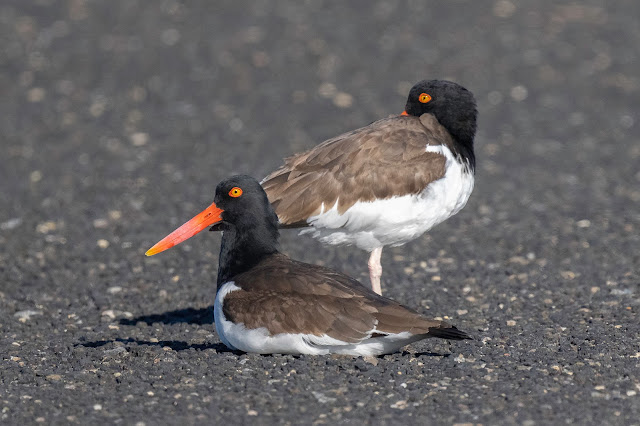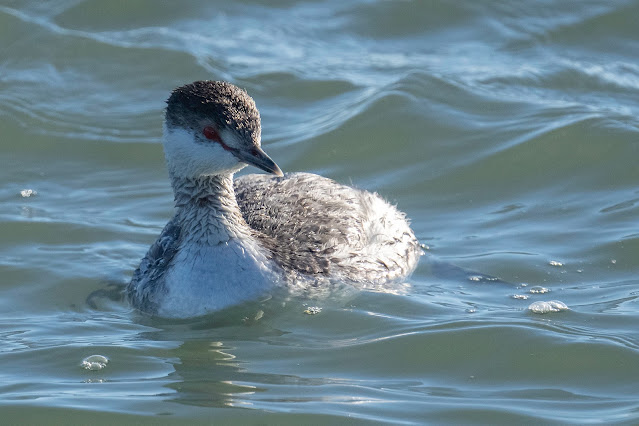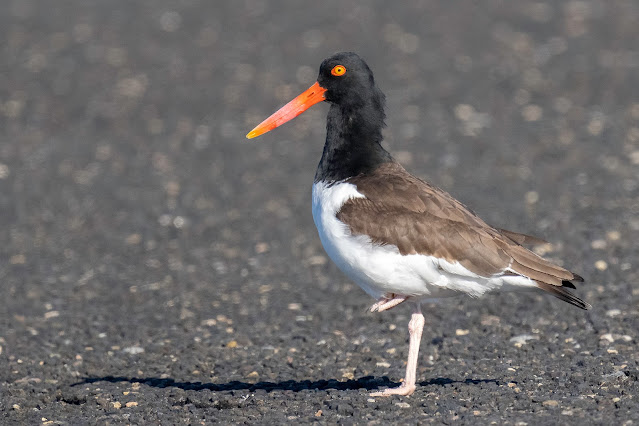Huntington Beach, SC - 11 Mar 2023
The Sun was still below the treeline when we walked out onto the pier. Last week the pond was thick with migrating ducks but today was largely absent save for a few Bufflehead and Hooded Mergansers. The shoreline was lined with cattail and sedges, so we stopped and listened for birdlife. The "tick-tick-tick" of a Virginia Rail got our attention and soon a tiny orange and blue rail poked its head out from the cattails for a nervous forage. We would get a few photographs of it and a Swamp Sparrow but would dip on King and/or Clapper Rail. A pair of Sora called from nearby but failed to show.
Parking at the North Beach we headed to the ocean shoreline and walked approximately 1.2 mi toward the Jetty at the north end of the State Park. Only a handful of beach combers were out along with a single surf fisherman. Skies were clear and a chilly ocean breeze felt more refreshing than cold. A few Sanderlings danced in the surf and picked at jellyfish that had washed up overnight.
Higher up on the beach small sand dunes marked the transition into salt marsh. A few Black-bellied Plovers roosted quietly in the sand before running and flying off.
As we approached the jetty small flocks of Brown Pelicans floated over the surf to our right.
Finally reaching the jetty we scanned the inlet and quickly found a pair of Horned Grebes. One individual appeared larger than the other and had a more-pronounced white cheek patch that temporarily confused me for a Red-necked Grebe. Being severely backlit we had to walk until we had better lighting to confirm both birds to be Horned Grebes.
Halfway out on the jetty a Common Loon swam by close to the rocks.
Another couple Horned Grebes swam by and garnered some attention.
A Least Sandpiper was the only occupant at the tip of the jetty. Out on the buoys several Double-crested Cormorants were roosting. With a stiff breeze coming in off the ocean we set up scopes to scan the horizon and quickly picked up a pair of Red-throated Loons and several Northern Gannets flying out too far to photograph.
As I was scoping a Northern Gannet flying toward us several hundred yards out a second unidentified, long-winged tern appeared below it. It had impressions of a frigatebird, but when it banked toward the beach it showed flashes of white primaries and a white tail that was suggestive of a white-winged tern. The bird flew over the beach and disappeared over the salt marsh. I thought nothing more of it until we ran into a pair of other birders a few minutes later who saw the same bird. No clue what it was, but I had hoped to maybe re-spot it when we headed back that way. No luck.
As we walked back Jack spotted a pair of American Oystercatchers resting on the jetty ahead of us. I took the opportunity to get a few digiscoped images before photographing them w/ the a1 and 200-600.
Huntington Beach SP--Jetty, Georgetown, South Carolina, US
Mar 11, 2023 9:50 AM
Protocol: Incidental
Checklist Comments: Sunny breezy
27 species (+1 other taxa)
Red-breasted Merganser (Mergus serrator) 1
Horned Grebe (Podiceps auritus) 6
American Oystercatcher (Haematopus palliatus) 4
Black-bellied Plover (Pluvialis squatarola) 7
Semipalmated Plover (Charadrius semipalmatus) 45
Ruddy Turnstone (Arenaria interpres) 1
Sanderling (Calidris alba) 10
Dunlin (Calidris alpina) 6
Least Sandpiper (Calidris minutilla) 1
Western Sandpiper (Calidris mauri) 13
Bonaparte's Gull (Chroicocephalus philadelphia) 6
Laughing Gull (Leucophaeus atricilla) 12
Forster's Tern (Sterna forsteri) 36
tern sp. (Sterninae sp.) 1 While scoping a Northern Gannet from the jetty it was being followed by a smaller, dark, long-winged tern. It veered off for the salt marsh beyond the beach and flashed white wings and rump/tail area. Met another pair of birders and they had seen the same bird from the jetty next to the marsh. Unable to verify species but White-winged Tern came to mind. Unable to relocate.
Red-throated Loon (Gavia stellata) 2
Common Loon (Gavia immer) 2
Northern Gannet (Morus bassanus) 7
Double-crested Cormorant (Nannopterum auritum) 65
Brown Pelican (Pelecanus occidentalis) 30
Great Egret (Ardea alba) 70
Snowy Egret (Egretta thula) 4
Tricolored Heron (Egretta tricolor) 3
Osprey (Pandion haliaetus) 1
Bald Eagle (Haliaeetus leucocephalus) 1
Belted Kingfisher (Megaceryle alcyon) 1
Tree Swallow (Tachycineta bicolor) 6
Savannah Sparrow (Passerculus sandwichensis) 3
Red-winged Blackbird (Agelaius phoeniceus) 1
View this checklist online at https://ebird.org/checklist/S1
This report was generated automatically by eBird v3 (https://ebird.org/home)



























































Comments
Post a Comment
Please leave a comment. I will try to respond ASAP.